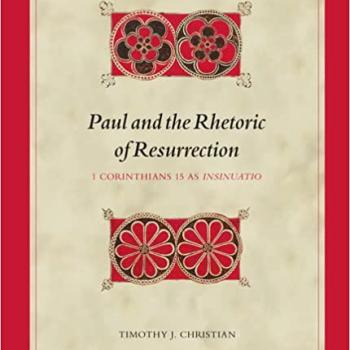Ben: One last comment on 1 Cor. 11– I don’t see any good reason why, if Paul was referring to ‘long hair’ he would use the phrase ‘down from the head’ since it is perfectly possible to say long hair in Greek.
COM: Do you see any good reason why, if Paul was referring to a garment covering, he would not use the phrase ‘down from the head’ since it is perfectly possible to say garment covering (such as kalluma or himation) in Greek? I suspect that Paul’s wording reflects communication he had received from Corinth, but in any case the wording is a challenge to every view.
Ben : As for the longish chapter on 1 Cor. 14— I wondered if you had looked at either the latest edition of the NIV.
COM: Yes, I have. It does not take a position, but rather concludes, “There is not enough evidence in these two verses alone to narrow down the options any further.”
It acknowledges that “Paul’s command in !Co 14:34–35 for women to remain silent in the churches is surprising.” It gives no indication that the evidence it has just cited for this is evidence against authorship by Paul. It simply assumes that this is “Paul’s command.”
It significantly understates the evidence that these verses were not originally by Paul. It mentions only one of the seven external evidences I list in Man and Woman, One in Christ, and understates that evidence to “a few manuscripts.”
It asserts, “no manuscripts lack these verses altogether and it is easy to understand why scribes might move them, because they seem to disrupt Paul’s flow of thought in teaching about spiritual gifts.” It ignores that within textual criticism, whenever a manuscript preserves or supports more than one text, each separate reading is identified with its own unique manuscript symbol. For the purposes of textual criticism, each is listed as separate manuscript support. It anachronistically equates what people today regard as disrupting Paul’s flow of thought in teaching about spiritual gifts” with “why scribes might move them.” It does not acknowledge that no scribes ever mention that they think these verses are out of place or that no other scribe ever moved any passage nearly this long this far away without an obvious reason. It does not identify as objections to authorship by Paul any of the nine internal evidences that Man and Woman, One in Christ identifies against it being by Paul.
Ben: Or more importantly have you seen the long marginal note in the NET Bible p. 2202 (probably I would guess from Dan Wallace) that rejects your conclusions of vss. 34-35 being a later insertion. You should read that lengthy note, for as they so there is no Greek text thus far that omits these verses.
COM: Dan Wallace’s exact words are, “these verses occur in all witnesses to 1 Corinthians.” But surely, Bishop Victor of Capua’s having 1 Cor 14:34-40 in Codex Fuldensis rewritten with a substitute text that omits 14:34-35 is a “witness to 1 Corinthians,” and these verses do not occur in his witness. We know that Victor originated this and other corrections in Fuldensis because he twice at the end of Codex Fuldensis identifies that he, Victor of Capua, read through and corrected the manuscript, both times writing the exact day, month, and year he completed both rounds of corrections.
Furthermore, Vaticanus’s distigme-obelos symbols are witnesses to the text. All sixteen instances coincide with a four or more consecutive word addition to the text, and in all fifteen by the original scribe, scribe B left a gap in the text at the precise point the original text was interrupted, including the interruption of the original text by 1 Corinthians 14:34-35.
Miller and Wallace’s statements that the symbol is in the wrong location ignores the consistent pattern in all sixteen cases. In all sixteen cases, the symbol marks the line where the original text was interrupted. Four or more consecutive word additions to the text noted in NA28 and/or Swanson occur on average only once in 83.5 lines of Vaticanus text. If this symbol is unrelated to blocks of added text, why does one occur in all 16 cases?
Wallace wrote long ago, not even mentioning my response to Miller in JSNT that refuted every one of his objections, long before my 2017 NTS article, and long before I identified all sixteen distigme-obelos symbols in The Bible vs. Biblical Womanhood. Wallace’s old article alleges in its final note, “Payne did not look at a control group.” This is not true. P. 253 of that 1995 NTS article compares the textual variants in the 23 “bar-umlaut” lines (a title Wallace is right to criticize) to each of the 20 lines in Vaticanus that follow each one. P 256 of that article compares the textual variants in the 12 “separated bar-umlaut” lines (a title Wallace is right to criticize) to each of the 20 lines in Vaticanus that follow each one.
BEN: As for me, I don’t think one needs to argue for omission. It’s perfectly possible to make sense of the text as it is by taking into account the previous reference to silence while someone else is speaking in the assembly, Anyway, Victor of Capua is a sixth century figure which is much too late to count as a witness to the original form of Paul’s texts.
COM: But those passages identify specific situations in which silence is required. 1 Cor 14:34–35 does not limit the kind of speech or silence that is demanded in any of its three commands or implications that women must be silent in the churches. The reiteration of an absolute statement three times was a literary device that reinforced the finality of the demand. Church fathers regularly acknowledge the conflict with chapter 11 and “all may prophecy” throughout chapter 14, but the dominant view was that Paul “sewed up their mouths.”
BEN: But the questions by women can be understood in light of the practice of asking the nearby oracle at Delphi questions. What would be more likely than Gentile women used to seeing prophecy as a consultation service where questions were expect, to then ask questions in the Christian prophecy meeting, not realizing Biblical prophecy doesn’t work that way.
COM: But Paul makes it clear in 14:29 that the prophecy he is talking about is subject to questioning: “and let the others weigh what is said.”
BEN: Weighing is not the same thing as asking questions. As for the fact that some texts have the verses at the end of the chapter, this can just as well be explained by a later scribe not understanding the sequence of 33b to 34, and moving the text.
COM: This is pure conjecture. No early commentator indicates any objection to or a lack of understanding of the sequence of the text. It is not true that “this can just as well be explained by a later scribe not understanding the sequence of 33b to 34, and moving the text.” There is no other comparable transposition in any manuscript of any of Paul’s letters, including “Western” manuscripts. The only case of nearly such a long block of text in two different locations this far apart from each other has an obvious explanation, the different endings of Romans.
BEN: You are forgetting that John 7.53-8.11 shows up in several places in the Gospel of John and even in the Gospel of Luke. It is a text looking for a home.
Ben: Sadly most pastors, even most conservative ones don’t know Greek well or at all, and certainly will glaze over at the technical discussion about obelisks etc in Chapter Six. And when that happens they will stop reading, and miss some really important stuff that follows that chapter.
COM: Early responses have not mentioned any “reader fatigue”. I gave a detailed treatment of the 1 Corinthians text-critical issues and Vaticanus’s two-dot plus bar symbols to the Symposium on Church Leadership in Boise, Idaho last month on March 23. Afterwards, a group of seven high school students came up and said they loved it. I asked them, “Did you understand everything I said?” In unison they all said, “Yes!”
Ben: I find that response from high school students less than impressive. It’s rather like when the Zebedees responded to Jesus saying yes they were able to be baptized with the baptism Jesus was about to face (on the cross).





